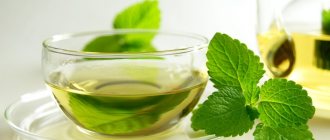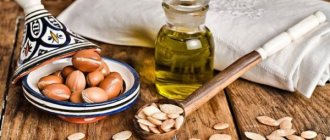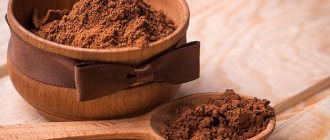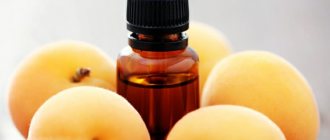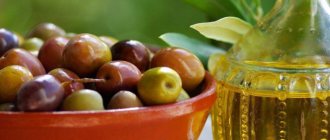One of the most popular and at the same time expensive base oils in cosmetology is jojoba oil. Strictly speaking, it is not exactly an oil, but rather a liquid wax that is obtained from the nuts of plants growing in the deserts of North America. The reputation of this oil is confirmed by more than a thousand years of history. It is completely unique in its chemical composition and beneficial properties, which are not lost even during long-term storage. Today we propose to talk about why and how to use jojoba oil, we will talk about its composition, dosages, and provide several beauty recipes using this component.
Main characteristics
In general, jojoba oil is extracted by cold pressing the nuts. During production, it retains absolutely all fatty acids, and due to the fact that it contains a huge amount of protein and vitamin E, jojoba moves from the category of ordinary base oils into a collection of the most effective antioxidants, agents that can quickly eliminate any inflammation.
One of the main characteristics of this oil is considered to be its high resistance to oxidation. This means that the aroma oil does not deteriorate and does not lose its unique properties over time, while being an ideal basis for dissolving any essential oils. Experts note: you can use jojoba oil in its pure form, but it is best to use it as a 10% solution, mixing it with other vegetable oils.
Jojoba is characterized by a light, almost imperceptible odor and a rich golden color. The oil changes its physical characteristics: at cold temperatures it hardens to the state of a waxy paste, and when warm it becomes relatively liquid. Cosmetologists note: jojoba is the only base oil that does not leave behind a greasy shine on either the skin or hair. At the same time, it is able to form a dense protective layer.
Review Reviews
According to reviews, jojoba oil perfectly smooths out wrinkles. The effect is noticeable within one to two weeks. After use, skin moisture is maintained throughout the day. This oil does not cause allergies, does not leave greasy stains on clothes or skin, and makes it smooth and velvety. It helps to cope with acne, cracks and small wounds, so it is highly appreciated by men as an additive to aftershave cream. Women note a calming and relieving effect after hair removal.
Hair becomes thicker after using balms with jojoba oil, after which it is not afraid of dry winds or damp weather.
Jojoba oil: composition
You can purchase this product at any pharmacies and cosmetic stores. In addition, you can also find granules of jojoba wax on the shelves, which were prepared by hydrogenation. You can add such granules to homemade cosmetics. The study of the composition and properties of jojoba began in the seventies of the last century. Researchers were able to find out that this oil is quite close in its biochemical composition to spermaceti. This is the name of a unique substance that was previously extracted from the frontal part of the head of sperm whales.
The main components of jojoba oil include fatty acids and their esters, amino acids, collagen, vitamin E, and carotenoids. Let us note that this composition is truly unique: it does not replicate any of the known vegetable oils. In addition to the fact that this composition has beneficial properties for the skin, it provides the oil with high stability: jojoba is not afraid of exposure to sunlight, oxidation and heat. Moreover, the oil can be stored for a long time even without the use of any additives. For this reason, it is often used as a preservative in the manufacture of cosmetics.
Properties of jojoba fatty extract
Jojoba oil is a viscous liquid of golden yellow color that hardens at a temperature of +10C.
What is it and what is made from it?
Jojoba oil is made from the Simmondsia chinensis plant. The name is incorrect; Simmondsia cannot be found in China, as it grows in the deserts and chaparrals of Arizona and Mexico. An error occurred during rewriting; California was confused with China. This is not the only confusion associated with this amazing plant. The Russian name “jojoba” comes from the Spanish “Jojoba”, read correctly “jojoba”.
Simmondsia chinensis is the only member of the Simmondsiaceae family. An evergreen shrub 1-2 meters high is perfectly adapted to life in the desert, because the roots go to a depth of 15-25 meters. The plant is dioecious. The flowers on male plants are yellow, and on female plants they are green. On female plants, nuts 12 mm long ripen and contain up to 60% oil.
For Simmondsia to grow, a temperature of 27-33 C is required, but it blooms after at least one month of damp, cool weather with a temperature of 15-20 C, and frosts of -3 C are detrimental to the plant. Because of these challenging environmental requirements, Simmondsia is grown in the USA, Mexico, Costa Rica, Peru and Argentina, and outside the Americas it is cultivated in Egypt and Israel. The first plantations appeared in India. Productivity – up to 3.5 t/ha.
This is what Simmondsia chinensis looks like
Cosmetic oil is extracted only by cold pressing, which preserves all the beneficial substances. This oil is expensive, it’s not for nothing that it is called “the gold of the desert.” Especially prized. For industrial use, grade 2 jojoba oil is used, obtained by extraction from cake and is noticeably cheaper.
It was first used as a lubricant additive for military purposes - for machine guns. Jojoba oil extract is added to lubricating oils for cars, machine tools and aircraft. It is also used in paints, varnishes, and plastics, where it improves the properties of surfactants.
Compound
Jojoba oil contains more than 97% esters of alcohols and unsaturated acids. Alcohols are represented mainly by eicose-11-enol, dodecose-13-enol and other alcohols with 18-24 carbon atoms and a double bond. The fatty acids included in the esters are gadoleic acid (76.7%), erucic acid (12.1%), oleic acid (9.3%), nervonic acid (1.0%) with 18-24 carbon atoms in the molecule.
In addition to esters, the oil contains 0.4% sterols, 63% of which is sitosterol, 24-methylcholesterol (18%), isofucosterol (7%) and stigmasterol (7%) are also present.
Contains more than 3% free fatty acids and higher unsaturated alcohols, significant amounts of tocopherols and calciferols, as well as proteins. You can also read about the composition of palm, coconut, hemp and camelina oils on the website.
Appetite suppression
The cake remaining after pressing the oil contains 33% protein. It is used as a feed additive, but to a limited extent, since the cake contains the glycoside Simmondsin, which has an appetite suppressant effect.
Rats whose diet included oil cake in an amount of 5-8% of the diet died from exhaustion after 3.5 months because they refused to eat.
Hepatotoxicity was observed, but only when administered orally. The injections did not cause liver damage even at high doses.
Simmondsin is being studied for possible use as a means to combat obesity, but all the side effects have not yet been clarified; it is too early to talk about its use in medicine, although experiments have established its effect even in small doses. Chia and flax seeds in the fight against excess weight.
Cosmetic use
Due to its unusual properties, jojoba oil is used in cosmetology, but to achieve maximum effect you need to know how to use it correctly. The uniqueness of jojoba oil is that it is 99% absorbed by the skin without leaving a trace, since it is almost identical to sebum.
Jojoba oil is extremely beneficial for hair: it gives it thickness and volume, and protects it from adverse weather conditions. Jojoba oil stimulates hair growth. For the face, it is combined with others: grape seed oil, wheat germ oil, peach oil, apricot oil.
For ease of use, care products come with a dispenser.
Use in cosmetology
The use of jojoba oil, according to cosmetologists, is almost limitless: it is an ideal component for basic and specialized skin care not only for the face, but also for the décolleté and neck. The product moisturizes and nourishes the skin, restores damage, relieves irritation, redness and inflammation. Jojoba is even suitable for caring for delicate skin around the eyes that requires special attention; it can be used in the manufacture of various vitamin applications and patches. Jojoba oil is also an excellent base for masks. The product has proven effective in treating chapped skin, including on the lips; it quickly eliminates rashes and cracking.
Cosmetologists note: the oil has anti-inflammatory properties, can stimulate the regeneration of skin cells, quickly heals cracks, injuries, cuts, dermatitis and irritation. Moreover, it can also be used in the fight against cellulite and to eliminate stretch marks. One more advantage of jojoba oil for the body, hands, and face should be noted: it is suitable for absolutely any skin type, and can be used by those with oily, normal, dry, problem skin - regardless of age.
Other positive properties of oil in cosmetology include protective, rejuvenating and cleansing. In addition, it can be used even by women who often experience allergic reactions to any skin care cosmetics.
Rules for selection and storage
Since we are talking about using the product on the body, poor quality can cause an allergic reaction, so you should be careful where you buy it - you should not do it in an unspecified place.
Studying packaging data reduces the risk of wasting time and money. For this reason, it is better to spend two or three minutes and read the data on compliance with GOST requirements, the country of origin (the shrub grows in the deserts of the south of the North American continent), and expiration dates. The contents should not be distinguished by the presence of sediment, pronounced aroma or tint - it is a clear oily liquid.
Should be stored out of reach of direct sunlight, in accordance with the expiration date indicated on the product packaging.
The main contraindication to the use of jojoba extract for facial care is individual intolerance to the product
Dosage Features
Using jojoba oil is not difficult: in order to enrich the cream or lotion, you need to add 15% of this oil to the finished composition. Jojoba oil for the face - in its pure form, mixed with other base oils - can be used for daily skin care after cleansing. If you want to prepare a nutritious mixture, combine jojoba, olive, apricot kernel and avocado oils in equal parts; for every two tablespoons of this mixture you will need one drop of lemon or orange essential oil.
If your skin is prone to flaking, you can use a tablespoon of jojoba oil with two drops of lavender. For aging skin, instead of lavender, patchouli oil is suitable, and tea tree oil can cope with the problems of skin prone to rashes. In order to obtain a suitable composition for the delicate skin around the eyes, you can add a drop of fennel or mint oil to jojoba oil. To care for lips with jojoba, it is better to combine lemon balm.
Using jojoba oil, you can prepare a unique smoothing mixture that can eliminate stretch marks: you need to combine jojoba, avocado, lavender, orange, mint and rosemary.
To care for your hair, you can add about 5 drops of jojoba oil to your shampoo or conditioner. At the same time, if it is important to solve the problem of hair loss, it is recommended to add sage and eucalyptus oil. A combination of jojoba, ylang-ylang and orange will help with dry hair; this composition must be applied to a wooden comb, which you use to comb your hair after washing. What else is jojoba oil good for? Experts talk about the effectiveness of massages, applications and compresses for various skin lesions.
Adviсe
Jojoba oil is thick and bioactive. Therefore, it is not recommended to use it as an independent remedy.
It is best to use it as a base and connect it with other components. It is optimal to mix with lighter oils in a 1:2 ratio. That is, dilute 1 part of the main product with 2 parts of another oil.
It is good to combine with peach, almond, apricot, and grape. It is quite convenient to measure oils with a syringe (without a needle).
Important: waxes contained in jojoba can provoke hair growth. This should be taken into account by those who have a mustache and fuzz on their face. In these cases, the dosage in the mixtures should not exceed 10%.
Oil damage
Speaking about the use of this amazing oil, it should be noted that individual intolerance to it is a rather rare phenomenon. However, before the first use, it is recommended to carry out a test: one drop of oil should be rubbed into the wrist. After half an hour, you should evaluate the condition of the skin: if redness appears, it is better to stop using the oil. If you decide to use jojoba oil daily all over your facial skin (especially if it is oily), you may trigger active sebaceous gland activity. The result is numerous inflammations.
How to choose quality oil
High-quality oil is usually sold in small bottles made of dark glass. The list of main producing countries includes the United States of America, Australia, Mexico, Egypt, Brazil, Argentina, Peru and Israel. It should be noted that in cold climatic conditions this plant is simply not able to survive, and therefore it is enough to look at the specified country to recognize a fake. It is best to store this oil in the refrigerator; before use, you need to heat only the amount that is needed to prepare the cosmetic product. This can be done either at room temperature or using a water bath. By the way, unlike other vegetable oils, this can be stored for several years - due to the fact that it contains a large amount of ceramides, which do not allow it to oxidize.
Application for face
This unique oil is widely used in the field of facial skin care. Its delicate texture allows it to be quickly absorbed, without leaving any greasy shine or unpleasant sticky film. The product does not clog pores, allows the skin to breathe freely and maintains its natural moisture level. You can use oil-wax for all areas of the face.
The product increases elasticity and firmness, makes the skin smooth and soft. Jojoba oil is widely used for the face against wrinkles, post-acne, dull skin color, swelling and acne. Some women use jojoba as a sunscreen if their skin is sensitive to ultraviolet light. You can apply it before tanning: powerful natural filters will not allow the skin to burn or redden, and the fabrics will not lose moisture in the sun. It is also recommended to use jojoba oil in the cold season: it will protect against hypothermia, chapping, and prevent flaking of the skin.
FAQ
Is jojoba oil a carrier oil?
Despite the fact that the chemical structure of this plant extract is a liquid form of wax, where there are no triglycerides, and fats are represented by higher fatty acids, this combination still refers to base oils. The product has conductive properties, therefore it is used in a mixture with ethers, acting as a stabilizer of volatile substances.
How is jojoba oil different from other base oils?
This extract of the seed part of the fruit of a shrub growing in desert conditions is distinguished from a number of liquid plant extracts by the following characteristics:
- wax by chemical structure;
- liquid state of aggregation;
- does not dry out;
- unique stability due to the high concentration of gadoleic acid;
- pronounced regenerative effect due to ceramides, amino acids, collagen;
- conductive properties and rapid absorption due to wax esters;
Thus, the oily liquid, which is a liquid form of wax, has a rich chemical composition and properties that no other oil has, and has significant differences from other products of a number of basic vegetable fats.
Does jojoba oil clog pores?
When asking this question, it is worth knowing that the formation of comedones as a result of clogging of skin pores can be influenced by the individual characteristics of the epidermis, inadequate quality of the product, the use of a composition that is not appropriate for the type of dermis, and other factors. The closeness of the ratio of the components of the product to the substances that make up the skin is of decisive importance.
In theory, cosmetologists rely on a selected amount of fatty acids - oleic, linoleic, linolenic - which are not contained in this product, and, according to the classification developed by American scientists, jojoba oil has a moderate tendency to cause the formation of comedones (comedogenicity index 2 points out of 5 maximum).
IMPORTANT. This fact suggests that use in its pure form is not recommended, so it is better to combine this product with ready-made products or include it in homemade masks, observing certain proportions.
The clear answer to the question is that this factor is determined individually, but if we take into account customer reviews, girls do not notice an increase in acne.
Where can you buy jojoba oil?
The unique properties of the product and unique chemical composition became the reason for its production on an industrial scale back in the 70s of the last century, so now the product can often be found in finished cosmetics or in its pure form.
The unrefined form (cold pressed) has the greatest benefit, which can be purchased at a pharmacy, soap making chain or specialized online store. Due to the low cost, it is worth paying attention to the place where the goods are sold - you should not buy in unidentified places, or second-hand. The label must contain information about the degree of purification, the country of origin, and compliance with GOST requirements.
Jojoba oil for the face: is it possible to use it in its pure form?
This plant extract has a thick consistency and a moderate comedogenic index. The absence of triglycerides in the chemical composition, the predominance of wax esters and the presence of rare fatty acids makes the product unique, but, by analogy with other base oils, cosmetologists do not recommend use in mono-variation over large areas - it is possible to apply it to the periocular area where there are no sebaceous glands or precisely on problem areas.
IMPORTANT. To eliminate cracking, peeling and other consequences of prolonged exposure to frost, it is possible to use it in its pure form every day, but only until the problem is eliminated.
Jojoba oil: what is it used for?
This product is distinguished by its uniqueness and rich chemical composition and, accordingly, a wide spectrum of action. It can often be found in industrial tanning products, balms/lipsticks/lip glosses, shampoos and other cosmetics. At home, the product is used for:
- eliminating fragility, excessive hair loss;
- giving strands shine;
- care for hands, nails, rough epidermis of heels;
- regeneration of the structure of damaged hair shafts;
- protection from the negative influence of environmental factors;
- treatment of diaper rash in babies;
- in the treatment of irritations, manifestations of allergic reactions, cracks, peeling, burns (excluding severe skin lesions), wounds;
- care for epidermis of any type;
- eliminating signs of aging, maintaining tone;
- combating stretch marks on the abdomen after pregnancy.
Considering the information presented, the product is multifunctional and has no age restrictions.
How to use jojoba oil for the face?
The method of application of the product is determined by the tasks and the problem posed. Possible options:
- in its pure form - apply for 15 minutes. on a previously cleaned, steamed face, removing excess with a paper towel;
- as part of homemade masks - a combination with other vegetable fats, which are classified as basic, essential oils;
- additive to industrial creams/masks (no more than 10%).
Since the chemical composition does not contain triglycerides, which improve penetrating ability, but there are substances that have a regenerative effect, it is advisable to combine the product with additional components.
Can I apply jojoba oil to my face at night?
If you have a number of problems or to eliminate signs of aging, you can use it as a mask (apply for 15 minutes). In some cases, the product can be left overnight, but not more than once a week. Since the main rule of using any home care products is to maintain regularity of procedures, and not to increase the exposure time, to achieve the required result, you should not leave the mask on for longer than 15-20 minutes.
The first results should be expected after at least 4 weeks of use, so a single soak for 8-10 hours will not solve all problems, and may result in impaired functioning of the lipid layer if used too often.
A feature of the product is rapid absorption, so keeping it overnight does not make sense in this case.
For body
Cosmetologists recommend using jojoba oil for the entire body: this will maintain a normal level of moisture and elasticity of the skin, make it tightened, and eliminate stretch marks. Regular application of the product to the neck, décolleté, and arms will help you look young and attractive longer. It should be noted that jojoba oil does an excellent job of removing rough tissue on the knees, palms, feet and elbows. It can also be used for cellulite changes in the skin, both for existing problems and as a preventive measure.
Beneficial properties of jujube
The fruits of this plant have a very good healing effect. I won’t give you recipes, there is enough information on the Internet, but I will tell you about the properties.
- List of flowering vines for gazebos
Jojoba berries help cope with such a serious disease as hypertension, even in advanced cases. Jujube is often called breast berry because preparations of its fruits, bark and leaves are used in the treatment of diseases of the upper respiratory tract.
They also help with diseases of the gastrointestinal tract. The impact of jojoba on the air is equivalent to the impact of coniferous plants, which release large amounts of phytoncides into the atmosphere. In other words, jujube heals the air around it.
Eastern peoples have a belief that jujube drives away evil spirits from the house, so it is often planted directly at the entrance. It has been noticed that snakes never crawl towards jujube, and for Zaporozhye, where I now live, snakes are quite a serious problem, I have met them here more than once. Jojoba fruits are also used in cooking: they can be used to make jam, marmalade, jelly, compotes, and they can be pickled. Pickled jujube tastes like olives. And for those who like to drink, I would like to inform you that compote made from jujube fruits is an excellent hangover reliever.
In my opinion, jujube is a very interesting and very necessary plant in the garden: it does not require care, perfectly bears fruit, is healing and tasty. And I definitely recommend it to you for growing.
For curls
When talking about what jojoba oil can be used for, we cannot fail to mention hair. Wax from seeds nourishes and moisturizes curls from roots to ends, restores structure, solving the problem of dandruff, normalizing the functioning of the sebaceous glands. Indications for wax use include the following:
- dry hair;
- lack of volume;
- dandruff;
- slow hair growth or loss;
- increased greasiness;
- damage due to chemical perms, bleaching, frequent use of straightening irons, hair dryers and curling irons.
What it is
Jojoba oil is an oily liquid obtained by cold pressing the seed part of the fruit of a plant that grows in the desert regions of the southern part of the North American continent, called Simmondsia sinensis:
- Argentina;
- Mexico;
- Israel;
- Arizona;
- California.
Description of Simmondsia chinensis:
- bush;
- height from 1 to 2 meters;
- length of the root system – from 10 to 25 meters;
- method of pollination - by wind;
- flowering period - spring;
- The shape of the fruit is triangular boxes.
Description of jojoba oil, which is obtained from the fruit:
[product_block id=”11007″]
- smell – neutral, weakly expressed;
- state of aggregation – liquid;
- transparent;
- texture – oily;
- boiling occurs at a temperature of 389.0 degrees/C, freezing - from 7.0 to 10.0.
Due to the absence of a pronounced aroma, the extract has found use in perfumery, namely the production of solid perfumes.
For eyelashes
Do your eyelashes fall out, break or grow poorly? Jojoba oil, used in its pure form, works real miracles. It should be applied along the edges of the eyelids, thereby nourishing the follicles and strengthening the eyelashes. In addition, this allows you to awaken the bulbs, which are currently in the sleep phase. This significantly increases the volume of eyelashes, they become darker, longer, and the look becomes more expressive. You can use jojoba oil to remove eye makeup.
Origin and chemical composition
The source of this valuable product is the fruits of an evergreen tree growing in the arid areas of America - Simmondsia sinensis. The nuts are removed by hand and then cold pressed. The process produces a semi-liquid golden substance with a subtle aroma, which hardens at zero temperature.
Based on its physical and chemical properties, the substance called “oil” would be more appropriately classified as “vegetable wax”.
Use undiluted
Why is jojoba oil used in its pure form? Cosmetologists say: this product should be applied to those areas where the skin is especially dry, dense or rough, for example, on the elbows, knees, lips or heels. It is recommended to repeat the procedure only a couple of times a week. You should be especially careful when using pure oil on your face: this can eliminate deep wrinkles, but too frequent use of wax can clog the cells. The best way to use pure oil is as a mask or application. It is enough to apply the product to the skin with a brush or soak a cloth with it. After fifteen minutes, it is recommended to rinse off the product with warm water.
For wrinkles
Thinking about using jojoba oil on your face for wrinkles? You will need the following ingredients:
- one chicken yolk;
- a teaspoon of fat sour cream or cream;
- a tablespoon of jojoba oil;
- a teaspoon of liquid honey.
Preparation of the product is quite simple: you need to heat the honey and oil in a water bath, add the remaining ingredients, apply the product to the skin and leave for 20 minutes. After the specified time, it is recommended to wash off the mask with warm water.
For acne and oily skin
Worried about acne, oily and greasy skin? Try making a composition with the following ingredients:
- one tablespoon each of jojoba oil and white or blue clay;
- some warm water;
- half a tablespoon of calendula tincture;
- a couple drops of lavender essential oil.
Preparing the product is quite simple: you need to dilute the clay in warm water and add the remaining ingredients to it, mix well. The resulting mask should be applied to the skin. After the mixture dries, it should be washed off with warm water. After this, it is recommended to apply any moisturizer to the skin.
Planting jujube
I prepared the hole in advance by filling it with a fertile mixture of equal parts of garden soil and compost and spilling it with water. The rules for planting jujube do not differ from the standard ones. The root collar should not be buried under any circumstances. After filling the hole, you need to water the soil generously again, and when the water is absorbed, the surface should be mulched with mowed dry grass.
In order for the seedling to quickly adapt to a new place, it needs to be watered regularly at first, but then gradually watering should become less frequent.
For hair
What is jojoba oil used for hair? It allows you to solve problems such as damage and dryness, brittle hair, and slow growth. To prepare the mask you will need:
- a tablespoon of melted honey;
- 1 egg yolk;
- two tablespoons of jojoba wax;
- a couple of drops of sandalwood or neroli essential oil.
The main component of the product – jojoba – needs to be heated and the rest of the mask components added to it. The composition must be applied to the root part, and only then distributed over the entire length of the hair. It is recommended to warm the mask, keep it on your hair for 30-40 minutes, then rinse thoroughly with shampoo.
Jojoba oil is also suitable for oily hair. To do this, 1 tablespoon of the product must be mixed with two tablespoons of lemon juice and the pulp of one avocado. The composition must be applied to damp hair, rubbed in, and rinsed off after an hour.
Brief history of jujube
In China, jujube has been grown for several thousand years. From this country the plant came to the Mediterranean. It was brought by Genoese or Venetian merchants in the Middle Ages. Then this exotic spread throughout Europe, and then gained a strong position in the United States.
Jojoba is also grown in Ukraine, but so far only in amateur gardens. True, there were attempts to plant industrial gardens in Crimea, and my seedling was just brought from Crimea. Today I will plant it on my site.
For dry and sensitive skin
When talking about using jojoba oil for the eyes or for sensitive facial skin, cosmetologists recommend preparing a nourishing and moisturizing product from the following components:
- a tablespoon of jojoba oil and full-fat cottage cheese;
- a teaspoon of freshly squeezed carrot juice.
Preparation will only take a few minutes: the oil must be heated in a water bath, mix the juice and cottage cheese in a separate bowl, add warm oil and apply to the face for 15 minutes. After this, the remnants of the mask should be removed with a soft cloth and washed with warm water.
For hands
The skin of the hands is daily exposed to the adverse effects of temperature changes, ultraviolet radiation, comes into contact with hard water, household chemicals, and therefore needs daily protection, moisturizing and nutrition. Jojoba oil will help cope with this task. You can prepare various care products for your hands. We offer a composition that is suitable for daily use. The list of components is simple:
- ¼ part of a glass of jojoba oil, the same amount of emulsion wax;
- 50 ml water;
- 10-15 drops each of patchouli and incense oils.
In order to prepare such a homemade cream, it is recommended to combine wax and oil, heat them in a water bath and mix, then add essential oil, heat the water in a separate container to 40-50 degrees, and add to the composition. After this, all components must be thoroughly mixed again, poured into a glass jar and left in the refrigerator. The product can only be applied to clean hands.
Conditions for growing jujube
The only thing that jujube requires is the right location. You must fulfill two basic requirements: the place must be sunny, that is, completely open; Under no circumstances should the groundwater in this area be high.
As I already reported, the jojoba root system penetrates deeply into the soil, and if the roots are kept in water all the time, the plant will die. Therefore, the soil must be well-drained so that water does not stagnate in the roots. But jujube is absolutely undemanding when it comes to soil composition.
- Why do aster seedlings get sick after picking and what to do about it
I will now plant my seedling according to all the rules, that is, I will create good starting conditions for it, and then the plant itself will find moisture and nutrition, spreading the root system and extracting from the soil everything it needs.
Bare-rooted jujube is usually planted in the spring, in March-April. You can plant it even in May: its buds begin to awaken in late spring. I have a container seedling, so you can plant it in the summer, but it is advisable to do this not at noon, but in the late afternoon.

